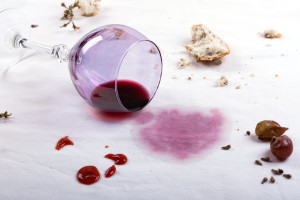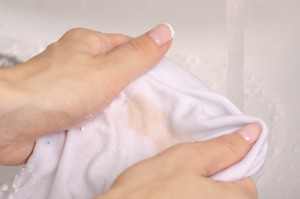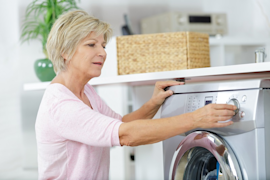How to pre-treat clothing stains


Red wine and chocolates might be synonymous with love, but there’s nothing lovely about the stains they can leave on clothing. Whether it’s wine, chocolate or something else that’s causing your laundry blues, showing your clothes a little love before you throw them in the washer could help them go from blah to bright again.
For more guidance on getting the most from your washer, plus troubleshooting tips and step-by-step repair guides to help fix washer problems, check out our washer repair help page.
For successful stain removal, Kenmore suggests you follow these simple steps.
Treat stains promptly, because a stain that sits is a stain that sticks. Check the care label on the stained garment for specific care instructions.
Use a pre-wash product, liquid detergent or a paste made from powder detergent and water to pre-treat stains. But first check for colorfastness by testing the stain removal product on an inside seam.
The end of this article has instructions for treating specific stains. But if you're not sure what kind of stain you're dealing with, use cold water to reduce the chance of setting the stain.
Once you treat the stain, wash the garment.
Stain-removing washer settings
Many washers have a setting that can help remove stains by adding soaking and/or agitation time before the main wash cycle. Look for setting names such as pre-soak, pre-wash or soak. Here are other unique features offered on today’s washers.
A steam cycle that allows hot steam to interact with fabrics to help remove tough stains. Don’t use the steam cycle with delicate fabrics such as wool, silk or easily discolored fabrics.
A "stain removal guide" button that allows you to indicate the type of stain on a garment (tomato, wine, grass or dirt). The duration or intensity of agitation changes, as does the water temperature, depending on the stain setting you choose.
A pre-treat/bleach cycle that adds liquid pre-treaters or liquid bleach at the correct time during the wash cycle.
The owner's manual that came with your washer has advice for using your specific washer model to remove stains.
Specific stain treatments
The most important thing you can do for a stain? Pre-treat it as soon as possible by removing the clothing and flushing the stained area with cold water.
Then, treat stains using these methods suggested on Kenmore.com and in your Kenmore owner’s manual.
Red wine: Coat the stain with salt. Stretch fabric over a bowl or sink and pour a stream of boiling water over the stain.
White wine: Rinse the stain with cold water. Spray with a solution of dish soap mixed with water (1 tablespoon clear dish soap mixed with 10 ounces water).
Baby formula, dairy products, eggs: Use product containing enzymes to pre-treat or soak stains. (Enzymes are a type of protein used to break down other protein or grease stains and dirt. Enzymes can be found in detergents and stain removal products.) Soak for 30 minutes or more. Wash.

Beverages (coffee, tea, soda, juice, alcohol): Pre-treat stain and wash using cold water and bleach safe for fabric.
Blood: Rinse with cold water and rub stain with bar soap. Or, pre-treat or soak with product containing enzymes. Wash using bleach safe for fabric.
Candle wax, crayon: Scrape off excess wax and place stain facing down between paper towels. Press with warm iron until wax is absorbed. Replace paper towels frequently. Treat remaining stain with pre-wash stain remover or nonflammable dry cleaning fluid. Hand wash to remove solvent. Wash using bleach safe for fabric.
Chocolate: Scrape off any dried chocolate and spray with dish soap solution before washing.
Cosmetics: Pre-treat with pre-wash stain remover or rub with bar soap.
Grass: Pre-treat or soak in warm water using product containing enzymes. Wash using bleach safe for fabric.
Grease, oil: Scrape residue from fabric and pre-treat. Wash using hottest water safe for fabric. For heavy stains and tar, put towel under stain and apply nonflammable dry cleaning fluid to back of stain. Rinse thoroughly. Wash using hottest water safe to fabric.
Gum, adhesive tape, rubber cement: Apply ice cube to harden the gum and scrape away as much as possible. Place stain face down on paper towels. Saturate with a pre-wash stain remover or nonflammable dry cleaning fluid.
Ink: Some inks may be impossible to remove. Washing may set some inks. Use pre-wash stain remover, denatured alcohol or nonflammable dry cleaning fluid.
Ketchup: Apply a stain pre-treater before washing.
Mud: Brush off dry mud. Pre-treat or soak with product containing enzymes.
Mustard: Stretch the stain over a bowl and pour white wine vinegar through the fabric. Then apply the dish soap solution to the stain and let sit for 15 minutes.
Nail polish: May be impossible to remove. Place stain face down on paper towels. Apply nail polish remover to back of stain. Repeat, replacing paper towels frequently. Do not use on acetate fabrics.
Paint, varnish: For water-based paint, rinse fabric in cool water while stain is wet and then wash. (Once paint is dry, you can’t remove it.) For oil-based paint or varnish, use solvent recommended on can label. Rinse thoroughly before washing.
Perspiration: Use pre-wash stain remover or rub with bar soap. Rinse, then wash using non-chlorine bleach in hottest water safe for fabric.
Rust, brown or yellow discoloration: Use rust remove safe for fabric. Do not use chlorine bleach because it may intensify discoloration.
Salad dressing: Apply cornstarch to the stain to absorb the oil. Rinse with cold water and apply a small amount of laundry detergent directly to the stain.
Shoe polish: For liquid shoe polish, pre-treat with a paste of powder detergent and water. For shoe paste, scrape residue from fabric and pre-treat with pre-wash stain remover or on flammable dry cleaning fluid. Rinse, and then rub detergent into dampened area. Wash using bleach safe for fabric.
Most common symptoms to help you fix your washers
Choose a symptom to see related washer repairs.
Main causes: clogged drain hose, house drain clogged, bad drain pump, water-level pressure switch failure, bad control b…
Main causes: worn agitator dogs, bad clutch, broken motor coupler, shifter assembly failure, broken door lock, suspensio…
Main causes: bad lid switch or door lock, bad timer or electronic control board, wiring failure, bad water inlet valve a…
Main causes: broken lid switch or lid lock, bad pressure switch, broken shifter assembly, faulty control system…
Main causes: unbalanced load, loose spanner nut, worn drive block, broken shock absorber or suspension spring, debris in…
Main causes: no water supply, bad water valves, water-level pressure switch failure, control system failure, bad door lo…
Main causes: lack of electrical power, wiring failure, bad power cord, electronic control board failure, bad user interf…
Main causes: leaky water inlet valve, faulty water-level pressure switch, bad electronic control board…
Main causes: water heater failure, bad water temperature switch, faulty control board, bad water valve, faulty water tem…
Most common repair guides to help fix your washers
Effective articles & videos to help repair your washers
Use the advice and tips in these articles and videos to get the most out of your washer.

Find tips for using your washing machine efficiently to save energy and help reduce utility bills.…

Learn about all the convenient features on our Sears PartsDirect website that make your parts purchases easier.…

Get answers to frequently asked questions about Sears and Sears PartsDirect.…
